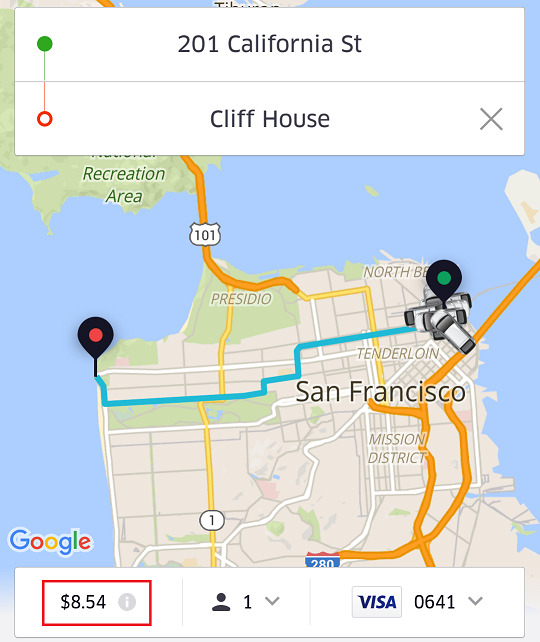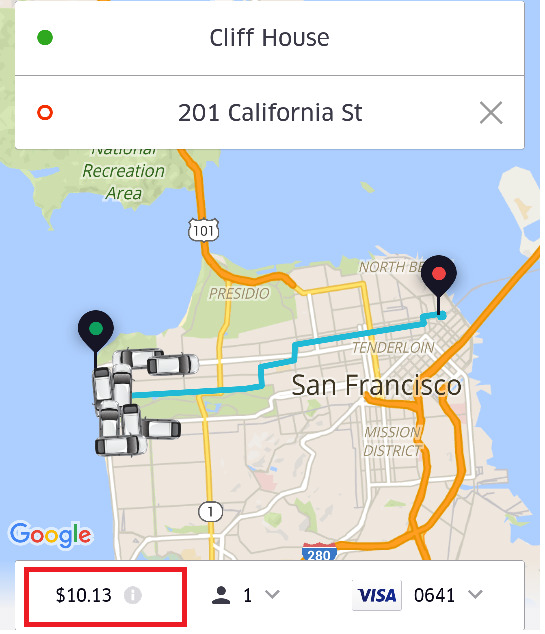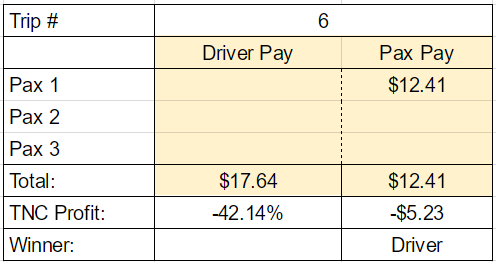Harry here. UberPool is a service that has been launching in more and more markets lately, and it’s not without its struggles. Today, Senior RSG Contributor Christian Perea examines exactly how drivers are supposed to be paid on UberPool rides, how that lines up with what passengers are paying, and how it compares to Lyft Line.
Over the last few months, Uber and Lyft have been rolling out their versions of shared ride services like UberPool and Lyft Line into new markets. If it’s not in your market yet, it is coming.
And although many have heard about these services already, there is still a lot of confusion and controversy around how these services pay drivers for their time. On the surface, it seems like drivers are doing a lot more work for about the same amount of money, but let’s take a closer look.
We sent out an expert driver to figure out EXACTLY how much Uber and Lyft are making on their shared rides…

Introducing: The Wanderer. The Wanderer is a real driver, and he drives full-time in San Francisco up to 70 hours a week, doing between 150 and 250 rides and earning between $3,000 and $4,000 in the process. His record week was above $4,000 just this March. He is a maniac. He collects guarantees from BOTH companies AND the Power Driver Bonus. He has around 15,000 rides between the two services. He cannot be bested.
Correction: The Wanderer became upset when we said he made between $2,000 and $3,000 a week originally, and reminded us that he has not made below $3,000 a week for a few months now.

Rides Are Heavily Subsidized During Launch
Whenever Uber and Lyft launch these services in new cities, they heavily subsidize the cost of rides for passengers. In addition, there’s usually no surge pricing or Prime Time on shared rides paid by the passenger. But they also make sure that drivers continue to get paid out just like a normal (surge or non-surge) trip so at the beginning, things seem pretty good – pay wise.
But over time, Uber and Lyft have both changed the way they pay these rides out.
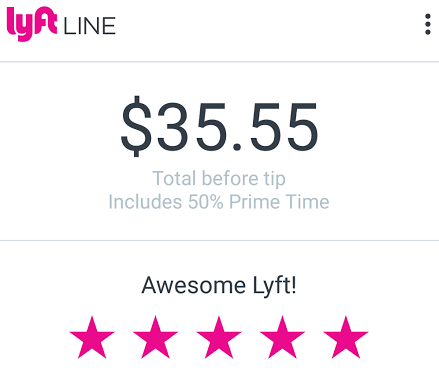
If these services come to your city, you can probably expect lots of promotions to help get the word out. So basically lots of hourly guarantees, guaranteed surge or PT, or other shenanigans around making people excited to give shared rides. So if they come, take advantage of them as a driver while they last.
How Much Does UberPool Cost The Passenger?
Let me get this out of the way first: pricing on UberPool is very confusing. But we’re going to attempt to make it as simple as possible.
There are several factors that affect the price a passenger pays for UberPool. Obviously every ride is based on mileage and estimated time, but time of day and the direction the rider is traveling also affect the cost of the ride.
Here is an example of two rides with the exact same distance, but reversed in pickup and drop-off. You can see that it actually costs more to head to 201 California from Cliff House than the other way. WTH is going on?
On rides where Uber’s algorithm calculates a higher chance of matching, they will charge each passenger less. On rides where Uber’s algorithm calculates a lower chance of matching, they will charge the passenger more.
When the morning comes, between 7AM and 9AM, prices will change again to match the likelihood of getting matched up. Those prices will drop to reflect a lot of people heading into the center of the city on their commute. Commute hours are when UberPool and Lyft Line are cheapest as a result of the predictably high volume and more people opting for these shared services.
How Do Drivers Get Paid Though?
UberPool pay for the driver is based off of time and distance in a similar fashion as UberX or Lyft. The difference here is that the driver will get paid a lower rate than what is paid out via UberX. In the East Bay market for example (as of 4/25/16), UberX pays out $0.15 a minute and $0.85 a mile with a $1.50 pickup fee. But UberPool will pay out to the driver only $.10 a minute and $0.75 a mile with a $1.75 pickup fee.
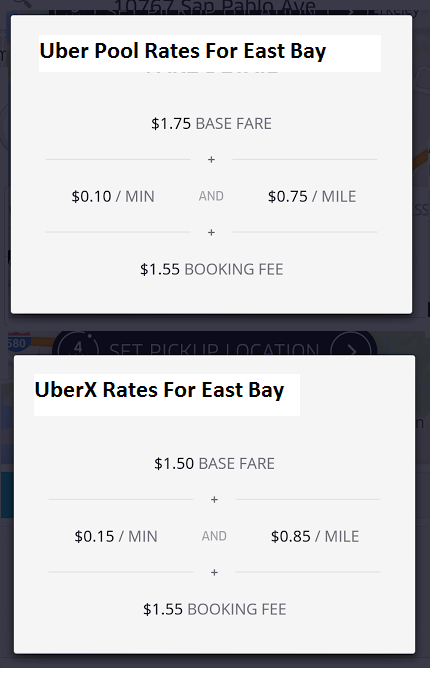
The rates are paid by the total time and distance you drive during the ride, with surge pricing applying to each UberPool fare separately (if any). So basically, you’re paid at the UberPool rate card from first pick-up until last drop off. What the passenger is charged though is a whole different story.
Surge Pricing: There are a lot of circumstances that affect surge pricing as it is applied to each passenger differently in UberPool. The same goes for Prime Time on Lyft Line. The amount you will get paid via surge pricing depends heavily on what rides have surge and in which order they are picked up, dropped off, or added within your queue. I could write another 2,000 word article on how all of that works alone. But not today.

Our Methodology
The Wanderer spent a week asking his passengers what they paid for their UberPool and Lyft Line rides. He would then record the amount on a notepad and note the corresponding ride within his Uber or Lyft application under ride history. In order to maintain some accuracy, he only recorded rides where the passenger could respond to within a tenth of a dollar “five sixty…something” while leaving out rides where people were unsure.
For each ride, we added the totals that each passenger stated to have paid for the ride and applied them towards what Uber or Lyft were collecting for the ride. This was recorded under “Pax Pay” (pax is shorthand for passenger FYI). We then recorded what the driver received for each ride under “Driver Pay” as a reflection of what they would be paid after their commissions were taken out by Uber or Lyft.
We added “Pax Pay” and “Driver Pay” separately and compared the two outcomes to see how much of a difference in pay there was for each ride (this number is basically Uber’s commission on UberPool rides). If Uber or Lyft made more money than the driver received, it was noted as “TNC Profit”. It is important to note though that we do not take into account company expenses for these rides and there is no way to determine if these rides are profitable for the company.
What We Collected: UberPool & Lyft Line Payout Spreadsheet
Booking/Trust Fee: Since the Booking/Trust & Safety fee are included in what the passenger pays, we did not add the service fees to what they reported as paying. We also did not subtract it from what Uber or Lyft would collect as total money since they ultimately get that money and the EXACT purpose of those fees is convoluted. What we do know is they get that money and it goes into operations costs for them.
UberPool is Pretty Profitable for Uber
Using the 10 rides that The Wanderer was able to collect on UberPool, we found that Uber had collected a total of $190.36 from the passengers that were driven. Of that $190.36 collected from passengers, the driver earned $143.11 in UberPool pay while Uber brought home $47.28 for a total commission across these ten rides of 24.83%.
However, when we look at rides on a case-by-case basis, the amount that Uber made from each ride varied significantly. Let’s compare a couple rides: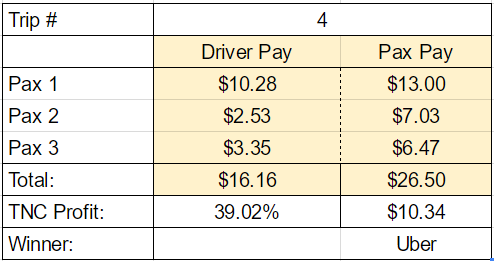
In this example, we see that The Wanderer made $16.16 in UberPool pay on this ride after commission while Uber made $26.50. So a difference of $10.34 or more than 33%! On this ride, Uber clearly made a nice profit. In fact, Uber carried a greater than 25% spread on 6 of the 10 trips we recorded.
In the table below, we see that Uber only made $1.75 off of this UberPool Ride, which was just 12.52% of the ride total.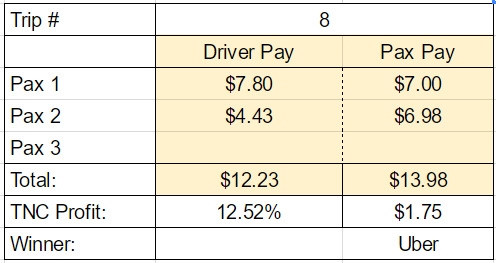
And then there was one outlier, a trip from San Francisco to Oakland which was long in distance and only had one passenger, where Uber made just $.26 or a 1% commission.
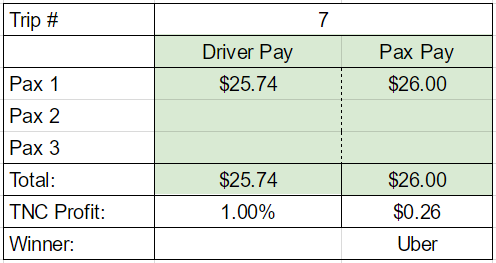
Although Uber’s ‘real’ commission varied greatly depending on the ride (anywhere from 1-39%), Uber did make a profit on every single ride.
Surge vs Non-Surge: Within our sample of 10 rides, the rides which had less surge seemed to generate the highest margins for Uber. If you check our spreadsheet, all of the rides where Uber took home above 35% in commission were UberPool rides with little to no surge pricing attached to them.
What We Collected: UberPool & Lyft Line Payout Spreadsheet
What We Found For Lyft Line
We gathered 8 Lyft Line samples and that revealed a few things. For starters, Lyft is more likely to lose money on a Lyft Line ride. Especially when it is not matched up. In our sample, we found that the total passengers paid across the 8 rides was $130.30. The driver made $116.36 while Lyft only made $13.94 or 10.69% as compared to Uber’s 24.90% of fares.
We actually found that Lyft lost money on 2 of its 8 rides, while making money on all the others. Here are a couple examples: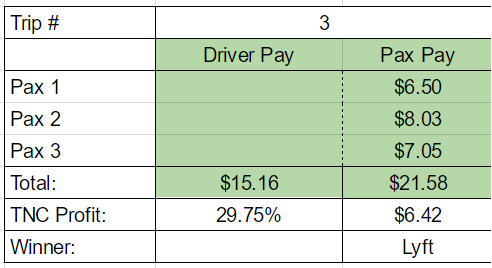
One thing that stands out is how much more profitable UberPool is than Lyft Line. It wouldn’t surprise me if Lyft adopted the UberPool lower rate cards in order to make more money on these rides eventually.
Insights On UberPool and Lyft Line Pay
Pool rides in San Francisco represent a mature market for the service, so we are likely looking at a situation where the market is more kind to Uber’s numbers at the moment. There is no telling how much Uber is making in other markets when they roll out the service, but probably not nearly as much. Lyft is obviously subsidizing Lyft Line more than Uber is UberPool so it will be interesting to see if this strategy is sustainable.
Drivers are still getting paid less for UberPool though when you factor in the distance and time it takes to fulfill these requests. Throw in the extra ticket risk and angst of multiple pick-ups and drop-offs and as a driver, you are now doing a lot more work for less pay and slightly better efficiency.
Admittedly, our sample size was very small and was limited to the passengers that we could reliably collect fare data from. And I really don’t think 18 rides between UberPool and Lyft Line are enough to determine exactly how profitable or not these services are for Uber or Lyft. I do however think that it is enough information to show that these companies are either already earning a profit on these rides or very close to doing so. So it provides a great characterization around whether or not these companies are really losing as much money as they claim when they roll-out these services.
My biggest fuss as a driver around UberPool pay is the separate pay rates on shared rides. Having this setup is really a way to cut prices even further without drivers knowing because they are paying attention to UberX or Lyft Classic rates. UberPool rates actually aren’t even published anywhere so you have to e-mail support@uber.com to figure it out, that doesn’t seem very transparent to me. As these services become used more often it seems that the companies intend to pass off the lowered prices to the drivers instead of relying on ways to make UberPool pay for drivers work as they were originally intended.

Drivers, what do you think about UberPool pricing and what’s your experience been like so far with UberPool?
-Christian @ RSG
